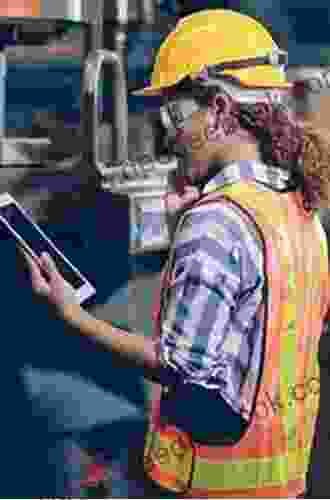The Digital Factory: The Human Labor of Automation

The digital factory is a rapidly evolving concept that is transforming the way we manufacture goods. By using digital technologies to automate tasks and processes, factories can become more efficient, productive, and responsive to customer demand. However, the transition to digital factories is not without its challenges. One of the biggest challenges is the need for a skilled workforce that can operate and maintain these new technologies.
The Human Labor of Automation
Despite the increasing use of automation, human labor remains an essential part of the digital factory. Humans are still needed to design, program, and operate the machines that automate tasks. They are also needed to monitor the production process and to troubleshoot any problems that may arise. In fact, the digital factory requires a workforce that is even more skilled than the workforce in traditional factories.
4.5 out of 5
| Language | : | English |
| File size | : | 937 KB |
| Text-to-Speech | : | Enabled |
| Screen Reader | : | Supported |
| Enhanced typesetting | : | Enabled |
| Word Wise | : | Enabled |
| Print length | : | 223 pages |
| Lending | : | Enabled |
The skills needed for the digital factory include:
- Technical skills: Workers need to have a strong understanding of digital technologies, including robotics, automation, and data analytics.
- Problem-solving skills: Workers need to be able to identify and solve problems that arise in the production process.
- Communication skills: Workers need to be able to communicate effectively with other members of the team, as well as with customers and suppliers.
- Critical thinking skills: Workers need to be able to think critically about the production process and to identify ways to improve it.
The Challenges of the Digital Factory
The transition to digital factories is not without its challenges. One of the biggest challenges is the need for a skilled workforce. As mentioned above, the digital factory requires a workforce that is even more skilled than the workforce in traditional factories. This can be a challenge for companies that are struggling to find qualified workers.
Another challenge of the digital factory is the cost of implementation. Digital technologies can be expensive to purchase and implement. This can be a barrier for companies that are looking to invest in new technologies.
Finally, the digital factory can be a complex environment to manage. The integration of different digital technologies can be challenging, and it is important to have a clear understanding of how these technologies work together. This can be a challenge for companies that are not experienced in managing digital technologies.
The Benefits of the Digital Factory
Despite the challenges, the digital factory offers a number of benefits. These benefits include:
- Increased efficiency: Digital technologies can automate tasks and processes, which can lead to increased efficiency. This can result in lower production costs and shorter lead times.
- Improved quality: Digital technologies can help to improve the quality of products by reducing errors and defects. This can lead to increased customer satisfaction and loyalty.
- Greater flexibility: Digital technologies can make factories more flexible and responsive to customer demand. This can help companies to meet the needs of their customers and to stay competitive in the market.
- Reduced waste: Digital technologies can help to reduce waste by optimizing the production process. This can lead to lower costs and a more sustainable operation.
The digital factory is a rapidly evolving concept that is transforming the way we manufacture goods. By using digital technologies to automate tasks and processes, factories can become more efficient, productive, and responsive to customer demand. However, the transition to digital factories is not without its challenges. One of the biggest challenges is the need for a skilled workforce that can operate and maintain these new technologies.
Despite the challenges, the digital factory offers a number of benefits. These benefits include increased efficiency, improved quality, greater flexibility, reduced waste, and a more sustainable operation. Companies that are able to successfully transition to digital factories will be well-positioned to compete in the future.
4.5 out of 5
| Language | : | English |
| File size | : | 937 KB |
| Text-to-Speech | : | Enabled |
| Screen Reader | : | Supported |
| Enhanced typesetting | : | Enabled |
| Word Wise | : | Enabled |
| Print length | : | 223 pages |
| Lending | : | Enabled |
Do you want to contribute by writing guest posts on this blog?
Please contact us and send us a resume of previous articles that you have written.
 Novel
Novel Page
Page Chapter
Chapter Text
Text Story
Story Genre
Genre Reader
Reader Library
Library Paperback
Paperback E-book
E-book Magazine
Magazine Sentence
Sentence Shelf
Shelf Glossary
Glossary Bibliography
Bibliography Codex
Codex Tome
Tome Narrative
Narrative Memoir
Memoir Reference
Reference Dictionary
Dictionary Narrator
Narrator Character
Character Librarian
Librarian Card Catalog
Card Catalog Borrowing
Borrowing Periodicals
Periodicals Study
Study Research
Research Scholarly
Scholarly Academic
Academic Reading Room
Reading Room Special Collections
Special Collections Interlibrary
Interlibrary Thesis
Thesis Storytelling
Storytelling Awards
Awards Book Club
Book Club Theory
Theory Textbooks
Textbooks Joan Irvine
Joan Irvine Nigel Salmon
Nigel Salmon Joseph E Schwartzberg
Joseph E Schwartzberg Maximilian Terhalle
Maximilian Terhalle Ardy Reed
Ardy Reed Sam Hodges
Sam Hodges Tammy Gagne
Tammy Gagne Gustave Aimard
Gustave Aimard Chris Evans
Chris Evans Elizabeth Mitchell
Elizabeth Mitchell Ted Staunton
Ted Staunton Edna Ferber
Edna Ferber Connie Goldsmith
Connie Goldsmith Shannon Karels
Shannon Karels Colin Roust
Colin Roust David L Ulin
David L Ulin Jane Godman
Jane Godman Keiji Sano
Keiji Sano P W Green
P W Green Jay Mcinerney
Jay Mcinerney
Light bulbAdvertise smarter! Our strategic ad space ensures maximum exposure. Reserve your spot today!

 Richard WrightShould We Stay or Should We Go: The Clash of the Titans and the Transcendence...
Richard WrightShould We Stay or Should We Go: The Clash of the Titans and the Transcendence...
 Marc FosterWitness the Enchanting Pig Display at Rugby Way Giftlands: A Journey of Art...
Marc FosterWitness the Enchanting Pig Display at Rugby Way Giftlands: A Journey of Art... Hamilton BellFollow ·6.4k
Hamilton BellFollow ·6.4k Bryce FosterFollow ·16.7k
Bryce FosterFollow ·16.7k Adrien BlairFollow ·6k
Adrien BlairFollow ·6k James GrayFollow ·11.9k
James GrayFollow ·11.9k Cruz SimmonsFollow ·15.7k
Cruz SimmonsFollow ·15.7k Tom ClancyFollow ·2.2k
Tom ClancyFollow ·2.2k Damon HayesFollow ·2.7k
Damon HayesFollow ·2.7k Reed MitchellFollow ·12.1k
Reed MitchellFollow ·12.1k

 Darren Nelson
Darren NelsonLife of Napoleon Bonaparte, Volume II: His Rise to Power
**** Napoleon...

 Reed Mitchell
Reed MitchellLucy Sullivan Is Getting Married: A Tale of Love,...
Lucy Sullivan is a...

 Chuck Mitchell
Chuck MitchellBeginner's Crash Course on Python Language: Getting...
Python is a widely used programming...

 Henry Hayes
Henry HayesThreads Fitting For Every Figure: A Comprehensive Guide...
Finding the perfect fit can be a...

 Duane Kelly
Duane KellyA Comprehensive Cat Guide to Money: Feline Finance for...
In the world of finance, humans have...

 Jedidiah Hayes
Jedidiah HayesThe Sentimental Hippo And His Friends
Harvey the hippo was a very sentimental...
4.5 out of 5
| Language | : | English |
| File size | : | 937 KB |
| Text-to-Speech | : | Enabled |
| Screen Reader | : | Supported |
| Enhanced typesetting | : | Enabled |
| Word Wise | : | Enabled |
| Print length | : | 223 pages |
| Lending | : | Enabled |








